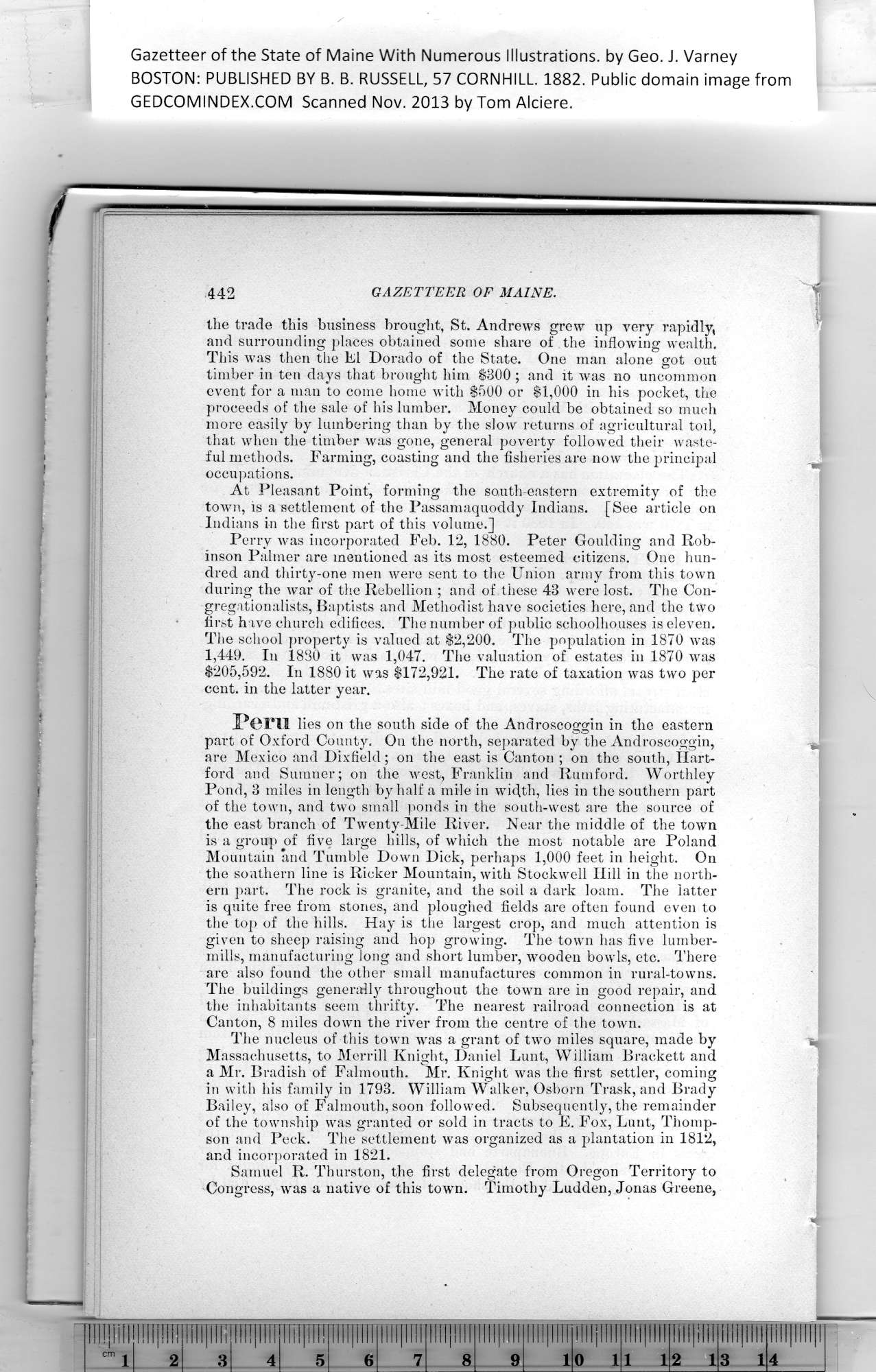|
Gazetteer of the State of Maine With Numerous Illustrations, by Geo. J. Varney
BOSTON: PUBLISHED BY B. B. RUSSELL, 57 CORNHILL. 1882. Public domain image from
the trade this business brought, St. Andrews grew up very rapidly,
and surrounding places obtained some share of the inflowing wealth.
This was then the FI Dorado of the State. One man alone got out
timber in ten days that brought him $300; and it was no uncommon
event for a man to come home with $500 or $1,000 in his pocket, the
proceeds of the sale of his lumber. Money could be obtained so much
more easily by lumbering than by the slow returns of agricultural toil,
that when the timber was gone, general poverty followed their waste-
ful methods. Farming, coasting and the fisheries are now the principal
occupations.
At Pleasant Point, forming the south-eastern extremity of the
town, is a settlement of the Passamaquoddy Indians. [See article on
Indians in the first part of this volume.]
Perry was incorporated Feb. 12, 1880. Peter Goulding and Rob-
inson Palmer are mentioned as its most esteemed citizens. One hun-
dred and thirty-one men were sent to the Union army from this town
during the war of the Rebellion ; and of these 43 were lost. The Con-
gregationalists, Baptists and Methodist have societies here, and the two
first have church edifices. The number of public schoolhouses is eleven.
The school property is valued at $2,200. The population in 1870 was
1,449. In 1830 it was 1,047. The valuation of estates in 1870 was
$205,592. In 1880 it was $172,921. The rate of taxation was two per
cent, in the latter year.
Peru lies on the south side of the Androscoggin in the eastern
part of Oxford County. On the north, separated by the Androscoggin,
are Mexico and Dixfield; on the east is Canton ; on the south, Hart-
ford and Sumner; on the west, Franklin and Rumford. Worthley
Pond, 3 miles in length by half a mile in width, lies in the southern part
of the town, and two small ponds in the south-west are the source of
the east branch of Twenty-Mile River. Near the middle of the town
is a group of five large hills, of which the most notable are Poland
Mountain and Tumble Down Dick, perhaps 1,000 feet in height. On
the southern line is Ricker Mountain, with Stockwell Hill in the north-
ern part. The rock is granite, and the soil a dark loam. The latter
is quite free from stones, and ploughed fields are often found even to
the top of the hills. Hay is the largest crop, and much attention is
given to sheep raising and hop growing. The town has five lumber-
mills, manufacturing long and short lumber, wooden bowls, etc. There
are also found the other small manufactures common in rural-towns.
The buildings generally throughout the town are in good repair, and
the inhabitants seem thrifty. The nearest railroad connection is at
Canton, 8 miles down the river from the centre of the town.
The nucleus of this town was a grant of two miles square, made by
Massachusetts, to Merrill Knight, Daniel Lunt, William Brackett and
a Mr. Bradish of Falmouth. Mr. Knight was the first settler, coming
in with his family in 1793. William Walker, Osborn Trask, and Brady
Bailey, also of Falmouth, soon followed. Subsequently, the remainder
of the township was granted or sold in tracts to E. Fox, Lunt, Thomp-
son and Peck. The settlement was organized as a plantation in 1812,
and incorporated in 1821.
Samuel R. Thurston, the first delegate from Oregon Territory to
Congress, was a native of this town. Timothy Ludden, Jonas Greene,
PREVIOUS PAGE ... NEXT PAGE
This page was written in HTML using a program written in Python 3.2
|
